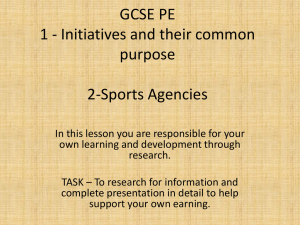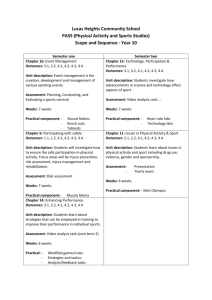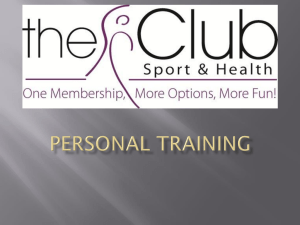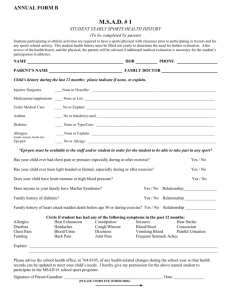GCSE Physical Education Revision Checklist
advertisement
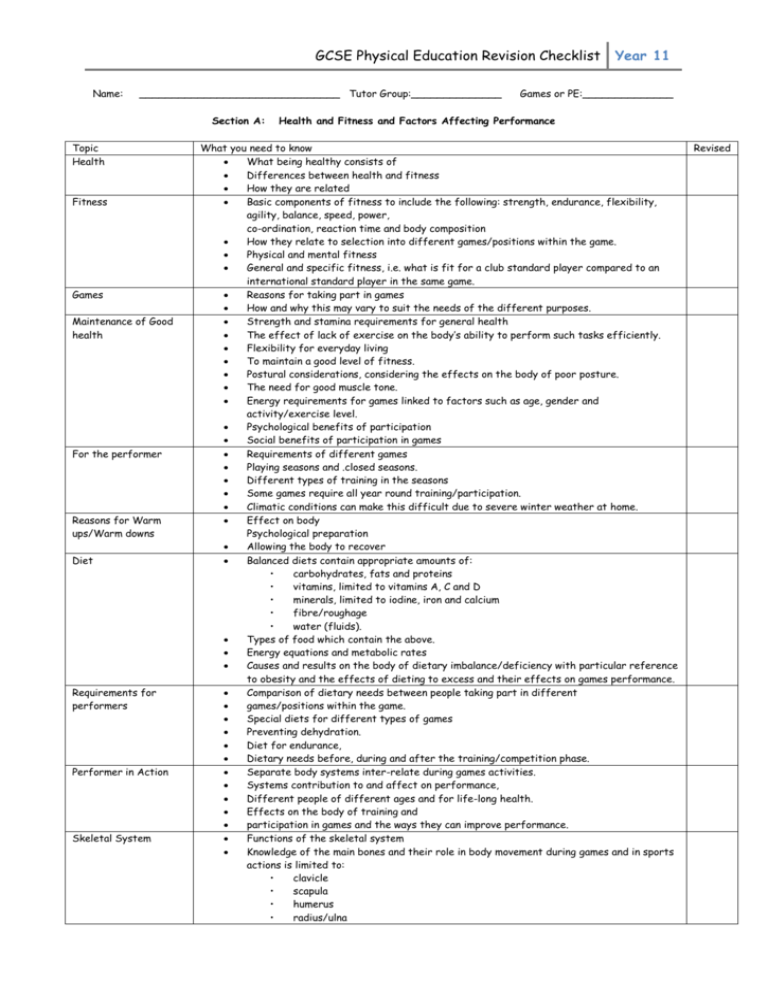
GCSE Physical Education Revision Checklist Name: _______________________________ Tutor Group:______________ Section A: Topic Health Fitness Games Maintenance of Good health For the performer Reasons for Warm ups/Warm downs Diet Requirements for performers Performer in Action Skeletal System Year 11 Games or PE:______________ Health and Fitness and Factors Affecting Performance What you need to know What being healthy consists of Differences between health and fitness How they are related Basic components of fitness to include the following: strength, endurance, flexibility, agility, balance, speed, power, co-ordination, reaction time and body composition How they relate to selection into different games/positions within the game. Physical and mental fitness General and specific fitness, i.e. what is fit for a club standard player compared to an international standard player in the same game. Reasons for taking part in games How and why this may vary to suit the needs of the different purposes. Strength and stamina requirements for general health The effect of lack of exercise on the body’s ability to perform such tasks efficiently. Flexibility for everyday living To maintain a good level of fitness. Postural considerations, considering the effects on the body of poor posture. The need for good muscle tone. Energy requirements for games linked to factors such as age, gender and activity/exercise level. Psychological benefits of participation Social benefits of participation in games Requirements of different games Playing seasons and .closed seasons. Different types of training in the seasons Some games require all year round training/participation. Climatic conditions can make this difficult due to severe winter weather at home. Effect on body Psychological preparation Allowing the body to recover Balanced diets contain appropriate amounts of: • carbohydrates, fats and proteins • vitamins, limited to vitamins A, C and D • minerals, limited to iodine, iron and calcium • fibre/roughage • water (fluids). Types of food which contain the above. Energy equations and metabolic rates Causes and results on the body of dietary imbalance/deficiency with particular reference to obesity and the effects of dieting to excess and their effects on games performance. Comparison of dietary needs between people taking part in different games/positions within the game. Special diets for different types of games Preventing dehydration. Diet for endurance, Dietary needs before, during and after the training/competition phase. Separate body systems inter-relate during games activities. Systems contribution to and affect on performance, Different people of different ages and for life-long health. Effects on the body of training and participation in games and the ways they can improve performance. Functions of the skeletal system Knowledge of the main bones and their role in body movement during games and in sports actions is limited to: • clavicle • scapula • humerus • radius/ulna Revised GCSE Physical Education Revision Checklist Movements Muscular System • • • • • • • • • • • Circulatory System Respiratory System Effects of training upon breathing and respiratory system Year 11 • sternum • ribs • pelvis • femur • tibia/fibula • patella. The different types of joint action that allow the movement Locations of the movable (synovial), immovable and slightly movable joints involved. Types of freely movable joints Range of movement limited to: flexion, extension, rotation, abduction and adduction. The basic functions in physical movement of cartilage and ligaments. The ways that muscles work in different games activities Major muscle groups and the associated skeletal structure. Voluntary (skeletal), involuntary (smooth) and cardiac muscle. The actions of muscles, prime movers (agonists), antagonists and synergists in different movements. Muscle attachment: origin and insertion and the role and function of tendons in achieving movement in games activities. Location of the following muscles biceps triceps deltoids pectorals trapezius abdominals latissimus dorsi gluteals quadriceps hamstrings gastrocnemius. How training affects the circulatory system The benefits of training for where high levels of endurance are needed. Production of the heart beat heart acting as a pump in a double circulatory system Methods of locating and recording the pulse blood pressure and pressure points The function and role of the blood in the transport of oxygen, glucose and waste products, body temperature control and protection. The effects of training upon breathing and the respiratory system Knowledge of parts of the breathing system is limited to: • air passages • trachea • alveoli • lungs The interaction of the intercostal muscles, ribs and diaphragm in breathing Gaseous exchange and the lungs as excretory organs for carbon dioxide. Respiration as the process that takes place in living cells Aerobic respiration in the presence of oxygen glucose + oxygen = energy + carbon dioxide + water Anaerobic respiration in the absence of oxygen summarised as: glucose energy + lactic acid. Oxygen debt The recovery process from vigorous exercise in games activities. GCSE Physical Education Revision Checklist Section B: Topic Fitness Training Specific Training Methods Muscular Endurance Strength Flexibility Fatigue Smoking and Alcohol Drugs Individual Differences Age Psychological Factors Technological Developments Year 11 Principles of Training What you need to know Specificity, Progression, Overload (including Frequency, Intensity and Duration), Reversibility, Repetitions/Sets, Tedium. Aerobic/Anaerobic Fitness . advantages and limitations. Advantages and Disadvantages of: Weight Training, Circuit Training, Interval Training, Fartlek Training, Continuous Training, Aerobic/Anaerobic. Ways of improving/developing muscular endurance Why different types of strength required for different activities, Static, Explosive Dynamic The importance of the difference between muscular strength and muscular endurance Ways of improving muscular strength Define The need for flexibility in games Ways in which improved flexibility can improve a players performance Ways of improving flexibility. The link between flexibility and strength and the need not to develop one to the detriment of the other. Testing flexibility such as the sit and reach test. Physiological Factors How and when fatigue occurs and the effects of it on skill level. Short and long term effects on performance in games. Knowledge and understanding of the effects is limited to the following: • Stimulants • Narcotic Analgesics • Anabolic Agents • Diuretics • Peptide Hormones, Mimetics and Analogues, • Beta Blockers • Blood Doping Body typing as Endomorph, Mesomorph and Ectomorph. Most suitable body type for a particular activity Knowledge of particular activity/position for each type and the reasons for their suitability. Physical maturity, suitability for certain games prior to maturity. Effects of performance at various ages up to and including retirement. The effects of the ageing process on the various body systems. Psychological Factors Tension. Anxiety. Boredom. Motivation. Personality and sport to include introvert, extrovert Examples of activities that suit particular personalities. Aggression in sport - direct and indirect with examples The importance of feedback in learning. Types of practice Types of guidance Simple definitions of open and closed skills Examples from activities of each. Equipment and materials used Effects on participation and performance in different activities and for different players. Improvements in facilities, safety factors and provision, teaching/training aids, etc. Use of advanced Information Communication Technology to also improve both knowledge and performance. Technological advances in the use of digital cameras/accurate recordings for analysis of achievement at world class level such as at the Olympic Games and World Championships, for example, instant replays, umpiring/refereeing (third umpire) decisions and statistical data e.g. speed of service etc. Revised GCSE Physical Education Revision Checklist Correct Actions, Clothing, Footwear to prevent injury Warm-Ups/ Warm-Downs Safety and the role of rules in relation to self and others Risk Assessment and First Aid Year 11 Safety and Risk Assessment Correct technique when taking part in games. Sports equipment The need for clothing to be appropriate to the game The need to have specific clothing to wear for games and to wash and clean it regularly. Correct sports footwear to give support to arches and to cushion the ankle joint on the impact when running or jumping. Effect of high back shoes, e.g. causing Achilles tendon damage. For safety and the prevention of injury in games activities Safety considerations that could apply in activities Role that rules play in making sure that taking part is as safe as possible (appropriate warm up, condition of the playing surface and equipment, the players actions being within the rules of the game and using correct techniques) Importance of adherence (sticking) to the rules and spirit of the game (to include responding positively to officials in charge and to any other instructions given by teachers/coaches, etc., affects safety) Common injuries associated with different games and the actions that should then be taken. Joint and muscle injuries . strains and sprains (tendon and ligament damage), pulled muscles and dislocations, soft tissue injuries including cuts and bruises. Understanding the principles of R.I.C.E. • Rest • Ice • Compression • Elevation. Recognition of fractures to upper and lower limbs. Recognition of the symptoms of concussion. GCSE Physical Education Revision Checklist Section C: Topic School Changing Attitudes Social Groupings Leisure Time Facilities Available Year 11 Factors Affecting Individual Performance and Participation What you need to know Importance of the school in promoting participation in games Requirements of the National Curriculum Different roles that pupils may adopt when taking part in games The provision of examination based courses, sports performance Awards/proficiency testing and awards. Provision of Extracurricular opportunities Attitudes of staff (both positive and negative) and experience of staff. The extent and quality of facilities available. Outside visits. Links to local sports clubs/providers. Cross-curricular work, e.g. health awareness and social education issues. The contribution of IT to the subject and the importance and link of the key skills. Effects of attitudes of society on participation in games. The importance of role models Women’s involvement in sport, playing and officiating Games growing in popularity and those declining in popularity . The effects of sports bodies or organisations such as Sport England, Governing Bodies, British Sports Trust (formerly CCPR) and the National Coaching Foundation Role of local authorities. Peers Family Gender Race Socio-economic Positive and Negative effects these groups have on performance and participation. Specific effects (both positive and negative) that peer pressure has participation. Reasons for increased leisure time Growth in the leisure Local Authority provision Provision of both outdoor and indoor facilities Issues regarding their location in terms of funding, access, acceptability, expected use and demand. Environmental aspects of provision. Advantages and Disadvantages to a country of hosting a major international sporting competition or event such as the Olympic Games, Commonwealth Games, or World Cup Tournaments. Provision for excellence and the facilities which might be provided for this. Range of games which must be catered for. User groups in terms of individuals, teams, clubs, regional/national squads − all ages, provision for training and competition. The role of Centres of Excellence. Acceptability, access, provision and the environmental issues involved. Revised GCSE Physical Education Revision Checklist Year 11 Section D – Social and Cultural Factors Affecting Participation Topic Sponsorship Media Social and Cultural Aspects Influences of Local and National Providers Impact on Performance and Participation in games What you need to know Advantages and disadvantages to the: sponsor, player and game. Examples of major games/sponsors, such as national teams, competitions, and the effects of sponsorship, e.g. prime time viewing. Dates, clothes, times of games changed to suit sponsor’s needs. Ease of obtaining sponsorship at various levels, at different profile levels of sport and for different games. Acceptable and unacceptable types of sponsorship. Forms of media coverage to include: • television • radio • the Press • information technology. How the media helps to give an understanding of performance and participation in games. Types of coverage including the various ways that television is broadcast. Different types of programmes broadcast e.g. informative, educational, instructive and entertainment. Importance of the individual’s/director’s influence on what might be seen or said in a game. Positive effects of media The rise of sports personalities as positive role models. Negative effects Effect on attendance at matches Lack of privacy for sports personalities Over sensationalising the game Conduct of players and officials. Etiquette Social/anti social behaviour of fans/supporters. Role of spectators Strategies employed to combat hooliganism, spectator behaviour. Influence of previous events in developing rules regarding all-seater stadiums and segregation of fans. Comparison of behaviour of players and spectators Political and financial issues related to major international sporting events The traditional differences between amateur and professional sport Open sport and loopholes for amateur players Local − provision for game activities in local areas through local authorities and sports development Provision for games through both the public and private sectors Awareness of specific roles within clubs Link between clubs and schools in terms of usage of facilities/opportunities for participation in games. The role of differing sports organisations Funding agencies for sport including the role of the National Lottery. Revised


